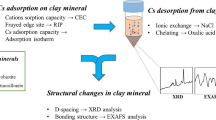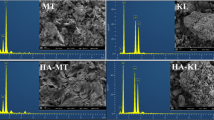Abstract
Sorption and desorption of Hg(II) on clay minerals can impact the biogeochemical cycle and bio-uptake of Hg in the environment. We studied the kinetics of the desorption of Hg(II) from kaolinite as affected by oxalate and cysteine, representing the ligands with carboxylic and thiol groups of different affinities for Hg(II). The effects of pH (3, 5, and 7), ligand concentration (0.25 and 1.0 mM), and temperature (15°C, 25°C, and 35°C) on the Hg(II) desorption were investigated through desorption kinetics. Our study showed that the Hg(II) desorption was pH dependent. In the absence of any organic ligand, >90% of the previously adsorbed Hg(II) desorbed at pH 3 within 2 h, compared to <10% at pH 7. Similar results were observed in the presence of oxalate, showing that it hardly affected the Hg(II) desorption. Cysteine inhibited the Hg(II) desorption significantly at all the pH tested, especially in the first 80 min with the desorption less than 20%, but the inhibition of the desorption appeared to be less prominent afterwards. The effect of the ligand concentration on the Hg(II) desorption was small, especially in the presence of oxalate. The effect of temperature on the Hg(II) desorption was nearly insignificant. The effect of the organic acids on the Hg(II) sorption and desorption is explained by the formation of the ternary surface complexes involving the mineral, ligand, and Hg(II). The competition for Hg(II) between the cysteine molecules adsorbed on the particle surfaces and in the solution phase probably can also affect the Hg(II) desorption.





Similar content being viewed by others
References
Arias, M., Barral, M. T., DaSilva-Carvalhal, D., & Mejuto, J. C. (2004). Interaction of Hg(II) with kaolin-humic acid complexes. Clay Minerals, 39, 35–45.
Benincasa, E., Brigatti, M. F., Malferrari, D., Medici, L., & Poppi, L. (2002). Sorption of Cd–cysteine complexes by kaolinite. Applied Clay Science, 21, 191–201.
Benoit, J. M., Mason, R. P., Gilmour, C. C., & Aiken, G. R. (2001). Constants for mercury binding by dissolved organic matter isolates from the Florida Everglades. Geochimica et cosmochimica acta, 65, 4445–51.
Biber, M. V., & Stumm, W. (1994). An in situ ATR-FTIR study: The surface coordination of salicylic acid on aluminum and iron(III) oxides. Environmental Science & Technology, 28, 763–768.
Bonnissel-Gissinger, P., Alnot, M., Lickes, J.-P., Ehrhardt, J.-J., & Behra, P. (1999). Modeling the adsorption of mercury(II) on (hydr)oxides II. α-FeOOH (goethite) and amorphous silica. Journal of Colloid and Interface Science, 215, 313–322.
Dashman, T., & Stotzky, G. (1982). Adsorption and binding of amino acids on homoionic montmorillonite and kaolinite. Soil Biology and Biochemistry, 14, 447–456.
Davis, J. A., & Leckie, J. O. (1978). Effect of adsorbed complexing ligands on trace metal update by hydrous oxides. Environmental Science & Technology, 12, 1309–1315.
Essington, M. E. (2004). Soil and water chemistry, an integrative approach. Boca Raton: CRC.
Evangelou, V. P. (1998). Environmental soil and water chemistry, principles and applications. New York: Wiley.
Evanko, C. R., & Dzombak, D. A. (1998). Influence of structural features on sorption of NOM-analogue organic acids to goethite. Environmental science & technology, 32, 2846–2855.
Evanko, C. R., & Dzombak, D. A. (1999). Surface complexation modeling of organic acid sorption to goethite. Journal of Colloid and Interface Science, 214, 189–206.
Filius, J. D., Hiemstra, T., & Van Riemsdijk, W. H. (1997). Adsorption of small weak organic acids on goethite: Modeling of mechanisms. Journal of Colloid and Interface Science, 195, 368–380.
Gilmour, C. C., Henry, E. A., & Mitchell, R. (1992). Sulfate stimulation of mercury methylation in freshwater sediments. Environmental Science & Technology, 26, 2281–2287.
Gunneriuson, L., Baxter, D., & Emteborg, H. (1995). Complexation at low concentrations of methyl and inorganic mercury(II) to a hydrous goethite (α-FeOOH) surface. Journal of Colloid and Interface Science, 169, 262–266.
Gunneriuson, L., & Sjoberg, S. (1993). Surface complexation in the H+-goethtite-chloride system. Journal of Colloid and Interface Science, 156, 121–128.
Haitzer, M., Aiken, G. R., & Ryan, J. N. (2002). Binding of mercury(II) to dissolved organic matter: The role of mercury-to-DOM concentration ratio. Environmental Science & Technology, 36, 3564–3570.
Haitzer, M., Aiken, G. R., & Ryan, J. N. (2003). Binding of mercury(II) to aquatic humic substances: Influence of pH and source of humic substances. Environmental Science & Technology, 37, 2436–2441.
Hamilton, W. P., Turner, R. R., & Ghosh, M. M. (1995). Effect of pH and iodide on adsorption of mercury(II) by illite. Water, Air, & Soil Pollution, 80, 483–486.
Horanyi, G. (2002). Specific adsorption of simple organic acids on metal(hydr)oxides: A radiotracer approach. Journal of Colloid and Interface Science, 254, 214–221.
Jackson, T. A. (1998). Mercury in aquatic ecosystems. In W. J. Langston & M. J. Bebianno (Eds.), Metal metabolism in aquatic environments. London: Chapman & Hall.
Johnson, S. B., Yoon, T. H., Slowey, A. J., & Brown, G. E., Jr. (2004). Adsorption of organic matter at mineral/water interfaces: 3. Implications of surface dissolution for adsorption of oxalate. Langmuir, 20, 11480–11492.
Kang, S., & Xing, B. (2007). Adsorption of dicarboxylic acids by clay minerals as examined by in situ aTR-FTIR and ex situ DRIFT. Langmuir, 23, 7024–7031.
Kirwan, L. J., Fawell, P. D., & van Bronswijk, W. (2003). In situ FTIR-ATR examination of poly(acrylic acid) adsorbed onto hematite at low pH. Langmuir, 19, 5802–5807.
Kubicki, J. D., Schroeter, L. M., Itoh, M. J., Nguyen, B. N., & Apitz, S. E. (1999). Attenuated total reflectance Fourier-transform infrared spectroscopy of carboxylic acids adsorbed onto mineral surfaces. Geochimica et Cosmochimica Acta, 63, 2709–2725.
Lambert, J. F. (2008). Adsorption and polymerization of amino acids on mineral surfaces: A review. Origins of Life and Evolution of Biospheres, 38, 211–242.
Lehninger, A. L., Nelson, D. L., & Cox, M. M. (1993). Principles of biochemistry (2nd ed.). New York: Worth Publishers.
Li, N. C., & Manning, R. A. (1955). Some metal complexes of sulfur-containing amino acids. Journal of the American Chemical Society, 77, 5225–5228.
Lin, C. J., & Pehkonen, S. O. (1997). Aqueous free radical chemistry of mercury in the presence of iron oxides and ambient aerosol. Atmospheric Environment, 31, 4125–4137.
Lockwood, R. A., & Chen, K. Y. (1973). Adsorption of Hg(II) by hydrous manganese oxides. Environmental Science & Technology, 11, 1028–1034.
MacNaughton, M. G., & James, R. O. (1974). Adsorption of aqueous mercury(II) complexes at the oxide/water interface. Journal of Colloid and Interface Science, 47, 431–440.
Mauclair, C., Layshock, J., & Carpi, A. (2008). Quantifying the effect of huamic matter on the emission of mercury from artificial soil surfaces. Applied Geochemistry, 23, 594–601.
Miller, C. L., Southworth, G., Brooks, S., Liang, L., & Gu, B. (2009). Kinetic controls on the complexation of between mercury and dissolved organic matter in a contaminated environment. Environmental Science & Technology, 43, 8548–8553.
Nriagu, J. (1994). Mechanistic steps in the photoreduction of mercury in natural waters. The Science of the Total Environment, 154, 1–8.
Parfitt, R. L. (1978). Anion adsorption by soils and soil minerals. Advances in Agronomy, 30, 1–50.
Sarkar, D., Essington, M. E., & Misra, K. C. (1999). Adsorption of mercury(II) by variable charge surfaces of quartz and gibbsite. Soil Science Society of America Journal, 63, 1626–1636.
Sarkar, D., Essington, M. E., & Misra, K. C. (2000). Adsorption of mercury(II) by kaolinite. Soil Science Society of America Journal, 64, 1968–1975.
Schluter, K. (2000). Review: Evaporation of mercury from soils: An integration and synthesis of current knowledge. Environmental Geology, 39, 249–271.
Schroeder, W. H., & Munthe, J. (1998). Atmospheric mercury—An overview. Atmospheric Environment, 32, 809–822.
Schuster, E. (1991). The behavior of mercury in the soil with special emphasis on complexation and adsorption processes—A review of the literature. Water, Air, & Soil Pollution, 56, 667–680.
Singh, J., Huang, P. M., Hammer, U. T., & Liaw, W. K. (1996). Influence of citric acid and glycine on the adsorption of mercury(II) by kaolinite under various pH conditions. Clays and Clay Minerals, 44, 41–48.
Skyllberg, U., Xia, K., Bloom, P. R., Nater, E. A., & Bleam, W. F. (2000). Binding of mercury(II) to reduced sulfur in soil organic matter along upland-peat soil transects. Journal of Environmental Quality, 29, 855–865.
Skyllberg, U., Bloom, P. R., Qian, J., Lin, C.-M., & Bleam, W. F. (2006). Complexation of mercury(II) in soil organic matter: EXAFS evidence for linear two-coordination with reduced sulfur groups. Environmental Science & Technology, 40, 4174–4180.
Sparks, D. L. (1995). Enviromental soil chemistry. San Diego: Academic Press.
Specht, C. H., & Frimmel, F. H. (2001). An in situ aTR-FTIR study on the adsorption of dicarboxylic acids onto kaolinite in aqueous suspensions. Physical Chemistry Chemical Physics, 3, 5444–5449.
Stumm, W., & Morgan, J. J. (1996). Aquatic chemistry, chemical equilibra and rates in natural waters. New York: Wiley.
Thanabalasingam, P., & Pickering, W. F. (1985). Sorption of mercury(II) by manganese(IV) oxide. Environmental Pollution (Series B), 10, 115–28.
Thurman, E. M. (1985). Organic geochemistry of natural waters. Berlin: Springer.
Tiffreau, C., Lutzenkirchen, J., & Behra, P. (1995). Modeling the adsorption of mercury(II) on (hydr)oxides I. Amorphous iron oxide and α-quartz. Journal of Colloid and Interface Science, 172, 82–93.
Uzum, C., Shahwan, T., Eroglu, A. E., Hallam, K. R., Scott, T. B., & Lieberwirth, I. (2009). Synthesis and characterization of kaolinite-supported zero-valent iron nanoparticles and their application for the removal of aqueous Cu2+ and Co2+ ions. Applied Clay Science, 43, 172–181.
Walcarius, A., Devoy, J., & Bessiere, J. (1999). Electrochemical recognition of selective mercury adsorption on minerals. Environmental Science & Technology, 33, 4278–4284.
Wang, J. S., Huang, P. M., Liaw, W. K., & Hammer, U. T. (1991). Kinetics of the desorption of mercury from selected freshwater ddiments as influenced by chloride. Water, Air, & Soil Pollution, 56, 533–542.
Weerasooriya, R., Seneviratne, W., Kathriarachchi, H. A., & Tobschall, H. J. (2006). Thermodynamic assessment of Hg(II)-gibbsite interactions. Journal of Colloid and Interface Science, 301, 452–60.
Weerasooriya, R., Tobschall, H. J., Seneviratne, W., & Bandara, A. (2007). Transition state kinetics of Hg(II) adsorption at gibbsite-water interface. Journal of Hazardous Materials, 147, 971–78.
Xu, R. K., & Ji, G. L. (2003). Effect of anions of low molecular weight organic acids on adsorption and desorption of aluminum by and from a kaolinite at different pH. Soil Science, 168, 39–44.
Yin, Y., Allen, H. E., Li, Y., Huang, C. P., & Sanders, P. F. (1996). Adsorption of mercury(II) by soil: Effects of pH, chloride, and organic matter. Journal of Environmental Quality, 25, 837–44.
Yin, Y., Allen, H. E., Huang, C. P., & Sanders, P. F. (1997). Adsorption and desorption isotherms of Hg(II) by soil. Soil Science, 162, 35–45.
Yin, Y., Allen, H. E., Huang, C. P., Sparks, D. L., & Sanders, P. F. (1997). Kinetics of mercury(II) adsorption and desorption on soil. Environmental Science & Technology, 31, 496–503.
Zhang H. (2006). Photochemical Redox Reactions of Mercury. In D. Atwood (Ed.) Recent developments in mercury science. Structure and Bonding, 120, 37–79
Zhang, H., & Lindberg, S. E. (1999). Processes influencing the emission of mercury from soils: A conceptual model. Journal of Geophysical Research, 104(D17), 21889–21896.
Acknowledgments
This work was supported in part by the US Department of Energy (DOE) Office of Biological and Environmental Research as part of the Science Focus Area at Oak Ridge National Laboratory (ORNL) and by the Environmental Sciences Ph.D. Program of the College of Arts and Sciences at Tennessee Tech University. ORNL is managed by UT-Battelle LLC for DOE under contract DE-AC05-00OR22725. The Research Assistantship provided for Wasana U Senevirathna by the Center for the Management, Utilization, and Protection of Water Resources of TTU is appreciated. We thank Dr. Jerry Lin for his advice on the dithizone method for spectrophotometric analysis of Hg(II). We thank all the reviewers for their suggestions and comments regarding the revision of the present article.
Author information
Authors and Affiliations
Corresponding author
Electronic Supplementary Materials
Below is the link to the electronic supplementary material.
ESM 1
(DOC 49 kb)
Rights and permissions
About this article
Cite this article
U Senevirathna, W., Zhang, H. & Gu, B. Effect of carboxylic and thiol ligands (oxalate, cysteine) on the kinetics of desorption of Hg(II) from kaolinite. Water Air Soil Pollut 215, 573–584 (2011). https://doi.org/10.1007/s11270-010-0500-3
Received:
Accepted:
Published:
Issue Date:
DOI: https://doi.org/10.1007/s11270-010-0500-3




